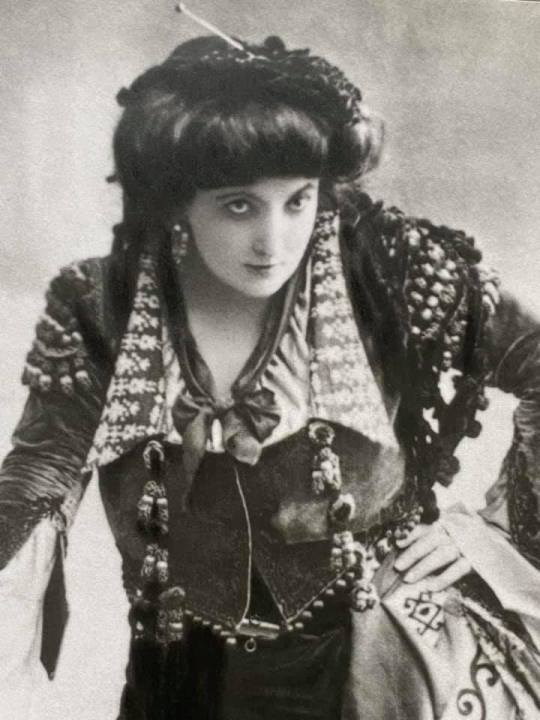#Rosa Mapleson
Text
youtube
Did another meme! Wanted to add more detail/frames but Krita said no :(
Regardless, hope you enjoy these weird bugs
#animation meme#insect character#anthro insect#furry art#2d animation#my art#tooneychaos art#Segments#Ava Heartmoth#Greg Trueant#Louie Blood#Rosa Mapleson#June Thorax#OCs#Youtube
3 notes
·
View notes
Text
Marcella Sembrich - Der Hölle Rache (LIVE fragment) - 1902 Mapleson Cylinder
Act II: Queen of the Night's second aria excerpt : "[alle] Bande der Natur" … to end of aria
Marcella Sembrich (s), Queen of the Night
Metropolitan Opera Orchestra
Walter Damrosch, conductor
January 27, 1902
Mozart's Singspiel had its first Metropolitan production, a lavish affair using designs from a successful Munich staging, on March 30, 1900, with an all-star cast including Marcella Sembrich (Queen of the Night), Emma Eames (Pamina), Zélie De Lussan (Papagena), Andreas Dippel (Tamino), Giuseppe Campanari (Papageno), Pol Plançon (Sarastro), Milka Ternina, Eugenia Mantelli, and Carrie Bridewell (Three Ladies), Suzanne Adams, Eleanore Broadfoot, and Rosa Olitzka (Three Genii); Luigi Mancinelli was the conductor. Five performances during what remained of the season attest to its success, though it did not return the following season. There were three performances in 1901-02 (at the first of which Mapleson made his single surviving cylinder from a Mozart work), and two the following season. Although the casts included a number of singers of German background, in these years Die Zauberflöte was always sung as Il Flauto Magico.
Marcella Sembrich, Poland’s most celebrated opera star, died in New York on this day in 1935. Born Prakseda Marcelina Kochańska, she adopted her stage name in Dresden before finding fame at Covent Garden and the Met, and was hailed as the Polish Nightingale and the Polish Patti.
#classical music#opera#music history#bel canto#composer#classical composer#aria#classical studies#maestro#chest voice#Marcella Sembrich#Der Hölle Rache#Der Hölle Rache kocht in meinem Herzen#Wolfgang Amadeus Mozart#the Polish Nightingale#Polish Nightingale#the Nightingale#the Polish Patti#Polish Patti#The Magic Flute#Die Zauberflöte#Queen of the Night#Königin der Nacht#dramatic coloratura soprano#soprano#Metropolitan Opera#Met#Royal Opera House#Covent Garden
1 note
·
View note
Text





Full pose/expression refs of my vigilante bugs! And yes, the bugs of this universe have no thoraces (part of the lore), but some may wear clothes with a mock-thorax (just not in this post)!
#character design#anthro character#anthro insect#Segments#I'm trying to keep these designs animation friendly#ava heartmoth#greg trueant#louie blood#rosa mapleson#june thorax
1 note
·
View note
Text

Bug portrait 4/5:
Rosa Mapleson: A rosy maple moth who works as a mechanic, but also has knowledge in biology, weaponry, and is even passionate about architecture.
#furry art#furry sfw#anthro moth#anthro insect#furry#oc portrait#segments#my art#tooneychaos art#rosalind mapleson
1 note
·
View note
Text

Joseph Maas (30 January 1847 in Dartford, England – 16 January 1886 in London) was an English tenor singer.He became a chorister in Rochester Cathedral. At first studying under J. C. Hopkins and Madame Bodda-Pyne, he went to study in Milan in 1869. In February 1871 he made his first success by taking Sims Reeves's place at a concert in London. In 1878 he became principal tenor in the Carl Rosa Opera Company, his beautiful voice and finished style more than compensating for his poor acting. Joseph Maas sang as a chorister at Rochester Cathedral before training with one of the Pyne sisters. In 1869 he trained in Italy under Sangiovanni. His London concert debut was in 1871, and two years later he appeared at Covent Garden in a pastiche called Babil and Bijou. He then moved to the USA for a period, touring as principal tenor of the Kellogg Opera Company. In 1878 he returned to London, and spent the rest of his career with Carl Rosa. His roles with the company included Rienzi, Wilhelm Meister, Manrico, Radamès and Des Grieux. He appeared briefly at other venues including the Norwich Festival. In 1880 he sang Faust for Mapleson, and in 1883 Lohengrin at Covent Garden. He was not a great actor, though he was thought to be improving at the time of his death. Nearly fifty years later, Hermann Klein wrote: "We have since had no English operatic tenor to be compared with him." He appeared in concert in Scotland, and a Dundee critic always spoke nostalgically of his appearances with the Choral Union.
Maas died from rheumatic gout on 16 January 1886
#Joseph Maas#Covent Gard#Mignon#Ambroise Thomas#Il trovatore#Giuseppe Verdi#Troubadour#Rienzi#Richard Wagner#Wilhelm Meister#Aida#Manon Lescaut#Giacomo Puccini#Charles Gounod#Faust
2 notes
·
View notes
Photo

Emma Calvé. Born 1858 in Décazeville; Died 1942 in Millau Rosa-Noémie Emma Calvé (actually Calvet) de Roquer was a flamboyant soprano and mezzo-soprano with a rich, powerful, well-equalized and superbly trained voice. Furthermore, she was a slim, attractive woman and a powerful actress. Her family moved from the village of her birth to northern Spain three months after she was born; she grew up speaking a mixture of French, Spanish, and Basque. Self-dramatizing in her biographies, she said she learned to sing and dance from watching the local gypsies and that later she learned the secret of pure high notes from Domenico Mustafà, one of the last of the castrati, who was director of the Sistine Chapel Choir. Wherever she got it, she had a solid extension to F above high C, a remarkable range for a lyric-dramatic soprano, particularly one with her repertory. She studied with Jules Puget and Mathilde Marchesi and had only indifferent success until she scored at La Scala with what would be one of her signature roles, Ophelia in Hamlet by Thomas. Even then she thought intelligently about the reasons for the prior failures and sought out two more teachers who would shape her career: Rosine Laborde (one of the greatest of voice teachers), and Eleonore Duse, the great actress. She had another success in the role of Suzel at the world premiere of L'Amico Fritz by Mascagni, and then gained another in what would become one of her signature roles, Santuzza in the same composer's Cavalleria rusticana. In 1892 she first sang Carmen. She ended up virtually owning the role. As long as memories of her live performances of the roles of Carmen and Santuzza remained in memory, it would be insisted she was incomparable in both parts. She sang Carmen over 3,000 times. In 1904 she announced her retirement from the operatic stage, but was persuaded to return to sing at Oscar Hammerstein's Manhattan Opera House in 1907 and 1908. She continued to give concerts and recitals until well into World War I. Her farewell appearance in North America was an emotional occasion for French war relief. She retired to a chateau in Millau where she was known as an excellent and tireless teacher, until she was stricken with a long declining illness. She left a small but important legacy of recordings, most made after she had passed her peak. Among them are some 1902 Mapleson cylinders made from the stage of the Met.
2 notes
·
View notes
Photo






MARIE ROZE
(born Maria Hippolyte Ponsin),
2 March 1846, – 2 June 1926
French soprano.
Debut at the Opéra-Comique 1865 . Her success there led to engagements with the Paris Opéra, and later in London. From 1876 she worked with the Carl Rosa Opera Company during their UK tours and in Scotland over a ten-year period sang roles ranging from Carmen and Manon to Marguerite] In 1877, she was engaged by the Max Strakosch Opera Company and made her American debut on 8 January 1878 in Philadelphia as Leonora in Donizetti's La favorita.
She later toured the United States with the Carl Rosa Opera Company from 1883 to 1889 and was particularly noted for her interpretation of the title role Bizet's Carmen. In 1890, she taught singing in Paris and made her farewell tour in 1894.
She studied singing at the Conservatoire National de Paris with Mocker and Auber. In 1865 she made her debut at the Opéra-Comique in Herold’s opera “Marie”.
In 1868 she created the role of Djelma in Auber’s “Le premier jour de bonheur” and in 1870 the role of Jeanne in Von Flotow’s “L’ombre”. For a long period she worked with the Carl Rosa Opera Company and toured the United Kingdom and the United States of America. In 1890 she set up a music school and taught singing in Paris. She made her farewell tour in 1894. Her first marriage was with the opera singer Julius (Julio) Perkins (1845-1875) and her second marriage with opera impresario James Henry Mapleson.
3 notes
·
View notes